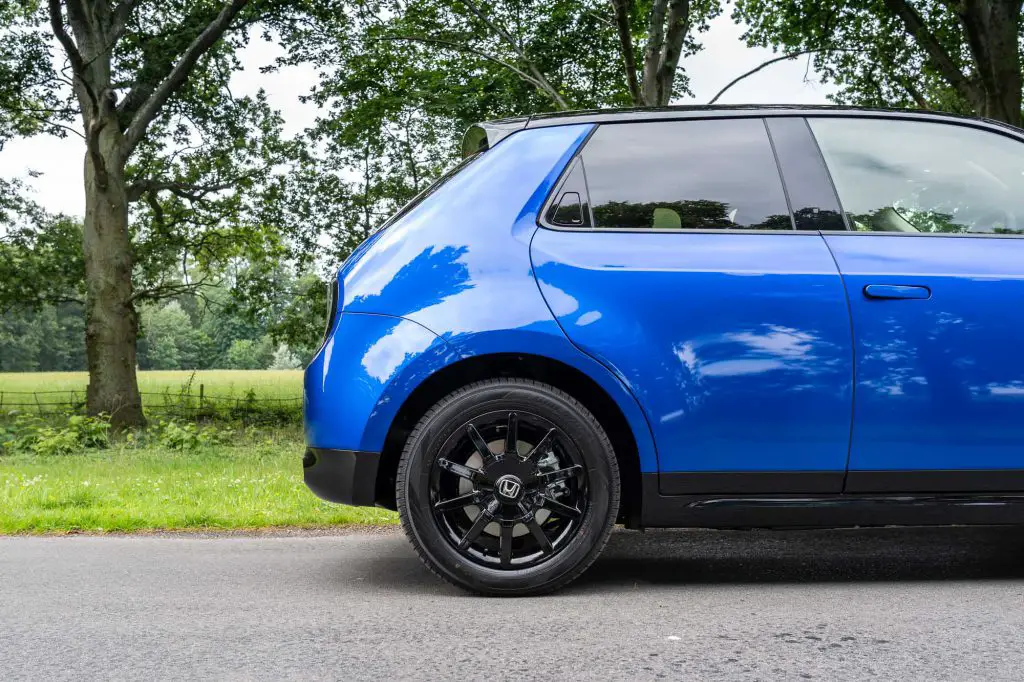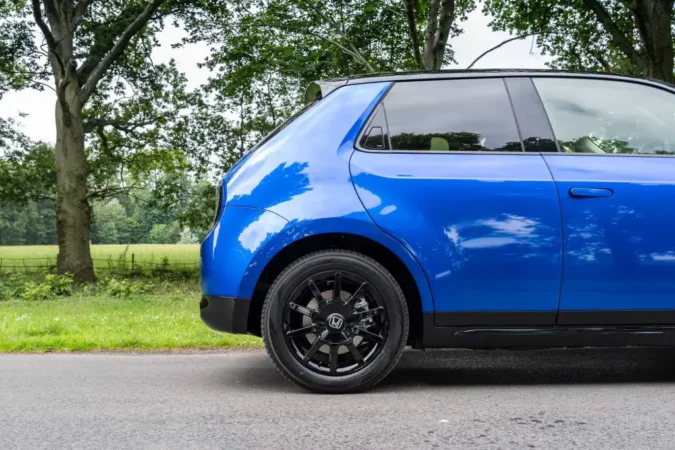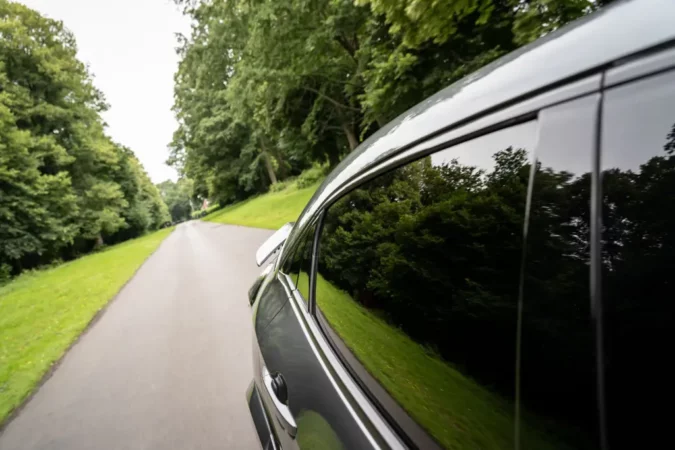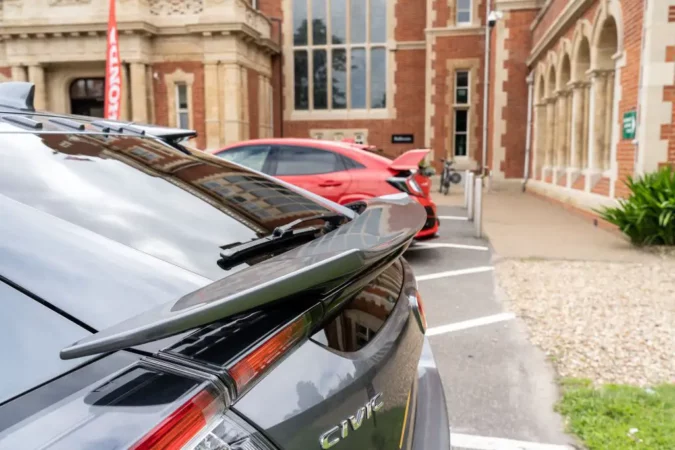Window tinting is becoming more and more common among car owners. It is the most effective option to shield the occupants from UV radiation and maintain a cool interior temperature. Nonetheless, how long does it take to tint windows typically? In order to tint car windows, a thin coating of tinted material is applied to the interior of the windows.
The size of the car, the type of tinting material being used, and the level of experience of the individual conducting the job are just a few of the variables that affect the answer to this question. Various film types offer varying degrees of protection and can cost differently. Polyester, metalized coatings, and ceramic are a few elements that are used to create this film.
There are several variables that can affect how long it takes to tint a car’s windows which we will explain in detail. A professional tinting job may be finished in a short amount of time with the correct equipment and know-how. Also, it can offer long-lasting protection and comfort to the occupants of the car.
- Best Tint For Car – Types Of Tints
- Ceramic Tint Vs Regular Tint
- Window Tint Percentages
- DIY Window Tinting Process
- How Long Does It Take To Tint Windows
- Final Conclusion
- FAQs
Best Tint For Car
Once you’ve decided to have the windows on your car tinted, the first consideration you should make is what type of window tint you want. The materials used to create each type of window tint film are distinct, and each has particular advantages and disadvantages. The film’s hue (darkness or lightness) within that category or quality should be your second choice.
There are various window tinting options on the market, each with special qualities and capabilities. The most popular window tinting options with their advantages and drawbacks are listed below. Otherwise, if you regret having put on that window tint in the first place, you can check out our detailed write-up on how to remove window tint.
Car Window Tinting Cheap – Dyed Window Tint Film
Dyed window film was the very first sort of manufactured window tint. It is a three-ply film containing an adhesive layer on the inside, a layer of dye in the middle, and a protective layer outside. It is the most widely used type of window tint because both the buyer and the installer pay the least for it.
Because of its low inventory cost, this film is most frequently utilized by newcomers and mobile window tinters. Moreover, it is the least resilient and with time turns bronze in hue. However, the interior of your car will still get rather warm because dyed window film does not reflect heat away.
We can equate dyed window tint film to donning a black shirt outside. The interior of the automobile will get hotter as a result of the dark, flat hue of dyed window tint film, which absorbs heat. However, dyed window tint film provides very little to block heat and is more useful for privacy and UVA/UVB protection.
Its lack of any metallic components means that dyed window film won’t interfere with your car’s electronics. These include GPS, tire pressure monitors, antennae, and phones (it also helps to learn how to connect my phone to my car). Car owners frequently use dyed window tints because they are inexpensive, provide decent privacy, and are readily available.
Best Tint For Car #1 – Metalized Window Tint Film
Another common option is metalized window film, however many individuals believe its disadvantages outweigh the advantages. It is made up of a metalized layer, and UV protecting layer sandwiched in between an adhesive layer, and a protective outer layer.
This sort of window tint benefits from the UV layer’s ability to provide crucial protection against UV rays. These rays can harm both you and the interior of your car. Metalized window tints are also a lot better than colored films at regulating the temperature inside your vehicle. The metalized layer can, unfortunately, seriously disrupt the electronic communication systems in your car.
The reception of your cell phone, GPS signal, and even your tire pressure sensors may be affected by this film. This happens especially if your antenna is not externally located in your car. It may also interfere with your radio. The majority of jurisdictions have made metalized window films illegal due to their reflective and glossy nature.
On the legal side of things, we’ve also previously discussed whether can you tint a lease car.
Best Tint For Car #2 – Carbon Window Tint Film
Regarding benefits and drawbacks, carbon window films are equally balanced. As carbon film doesn’t contain any metal, interference won’t be a problem. Also, it effectively blocks heat and UV rays, lowering the strain on your car’s HVAC system.
The reason carbon film is less common than the alternatives is likely due to the fact that, despite doing everything well, it is not the clearest of films and can warp over time. Carbon films’ ability to reject heat is dependent on how dark they are; as a result, getting darker will increase heat rejection. Yet carbon window tint film is an affordable option.
Interference won’t be a problem because carbon film doesn’t contain any metal. Also, it effectively blocks heat and UV rays. This will lessen the strain on the HVAC system in your car. Although it performs everything well, a carbon film is less common than the alternatives. This is presumably because it is not the clearest of films and can distort over time.
Since the darkness of a carbon film determines its ability to reject heat, adding darkness will increase heat rejection. Yet, window tint film made of carbon is inexpensive.
Best Tint For Car #3 – Ceramic Window Tint Car
The most widely used and expensive type of window tinting material for cars is ceramic. It offers the best heat rejection and clarity. Especially if you intend to retain your car for many years, the advantages of ceramic window tint justify its cost. Customers who demand the best in every aspect of their window tint will benefit from this film’s design.
In addition to blocking 98% of infrared light, ceramic window tints also block 99.9% of UVA and UVB rays from entering your vehicle. Infrared rays are what cause us to feel the heat from the sun. Hence, tinted windows lower the interior temperature of your car even if you have to park directly under the sun.
You can also conserve energy and money by reducing the amount of infrared light entering your car. When your car is already cool, you won’t need to operate the air conditioner as frequently. This puts less stress on your engine, gas tank, and wallet. Ceramic window tint film is available in all familiar lightnesses and darknesses.
However, its most alluring feature is that it eliminates the need to select a super dark window tint in order to get high heat rejections. Infrared heat is rejected by 98% even with a transparent ceramic window tint film. Moreover, ceramic window tint film provides the maximum level of optical clarity for the duration of the car.
Whether it’s day or night, it’s simpler to see out of your car windows because of this clarity. A 1000 SPF sun protection rating is available on premium ceramic window tint films. Ceramic is the best window tinting for decreasing sun and headlight glare. The finest solution for your car without a doubt would be ceramic window tint film.
Best Tint For Car #4 – Hybrid Window Tint Film
The finest qualities of metalized and dyed window films are combined in hybrid tinting film, which also strives to eliminate all of their shortcomings. The metalized layer will still provide some, but not all, of the UV protection of a regular metalized film. On the other hand, the dye layer will aid in giving it a blacked-out appearance.
It will be more resilient than dyed window film, and, it won’t interfere with your electronics as much because less metal was used in its production than a typical metalized film. It offers the best of both worlds by reducing interference and expense while delivering a nicely darkened appearance and UV protection.
Because it is more expensive than conventional tint (you can learn more about that in our explainer on the car window tinting prices and how much does ceramic window tint cost), ceramic tint is seen as a premium alternative. We’ll go over the distinctions between ordinary tint and ceramic tint to assist you in selecting the one that’s best for you.
Ceramic Tint vs Regular Tint
A ceramic tint has nano-ceramic particles coated onto the tint film. This type of tint provides better heat rejection, which allows it to block off more solar heat than standard tint. Moreover, ceramic tint is said to be more durable and resilient to fading than normal tint. Also, the tint becomes less reflective due to the ceramic particles, which lessens glare when driving.
On the other hand, normal tints are created from polyester sheets that have been dyed in a variety of colors and particular gradations, from lighter to darker. Although this type of tint is less expensive than ceramic tint, it might not provide the same level of heat rejection or durability.
Nonetheless, ordinary tints can still offer a sizable amount of UV protection and can aid in lowering the amount of heat that enters your car. Your budget and personal preference will ultimately determine whether you choose ceramic tint or conventional tint.
Ceramic tint can be a better choice for you if you are ready to spend more money on a higher-quality item that delivers excellent heat rejection and durability. But, standard tint might be the best option if you want something more reasonably priced and still offers a respectable level of protection.
In conclusion, your vehicle can benefit from both ceramic and conventional tint. Regular tint is less expensive and yet capable of offering a high level of protection, while ceramic tint offers improved heat rejection and durability. While selecting a choice, take into account your priorities and budget.
Window Tint Percentages
You will see two percentages quoted when you start considering various options. These would be reflectivity and VLT with VLT being the more important factor. These two numbers when combined tell you how dark the windows will be and how the tint will look.
While looking for window tinting, you will most frequently find the term VLT cited. VLT stands for Visible Light Transmittance and VLT percentage represents the amount of light coming in through the window. So, the lower the value, the darker the tint will be; 100% would let all of the light through, while 0% would be complete darkness.
How Long Does It Take To Tint Windows, Tint Percentages #1: 0 Window Tint
A car with 0% tint indicates that the windows are completely opaque and don’t let any light through. “Limo tint” or “complete blackout tint” are other terms that describe this particular hue. A 0% tint offers the best amount of privacy for the passengers since it makes it difficult for those outside to see inside.
But, it can also impair the driver’s ability to see outside the vehicle, particularly at night or in dimly lit areas. Given that it can decrease the driver’s visibility, this type of tint could be banned in most states.
How Long Does It Take To Tint Windows, Tint Percentages #2: 2 Window Tint
A 2% window tint is usually a very black window tint with a transparency of 2%, usually referred to as a “limo tint”. The rear windows of cars frequently have this type of tint applied since it provides the highest level of privacy and heat reduction.
It’s crucial to check the local regulations before installing it because it might not be permitted in most states or regions. Since limo tint might make it challenging to see out of the windows, especially at night, it’s crucial to exercise caution and adjust your mirrors properly.
How Long Does It Take To Tint Windows, Tint Percentages #3: 5 Window Tint
A “five percent tint,” also known as a window tint with 5% transparency, is extremely dark. It assures the highest level of privacy and heat reduction. This type of tint is frequently applied to car rear windows, while some states or regions may also allow it on front windows.
A five percent tint helps reduce glare and prevent UV rays. But it can also make it difficult to see out of windows (unless you need to figure out how to defog the windshield, or perhaps consider a car window replacement), especially at night.
How Long Does It Take To Tint Windows, Tint Percentages #4: 30 Window Tint
30% transparency window tint is a medium darkness shade. It provides some seclusion and heat reduction while still allowing for reasonable visibility. In most jurisdictions, it is acceptable to apply this type of tint on the front windows of vehicles. With only a slight reduction in visibility, 30% tint can provide advantages including glare reduction and UV radiation blocking.
However, make sure you’re wary of whether is 35 tint legal in NY (among other states and darker tint percentages).
How Long Does It Take To Tint Windows, Tint Percentages #5: 45 Window Tint
A light shade of window tint with 45% transparency provides only a little seclusion and heat reduction. In most jurisdictions, it is acceptable to apply this type of tint on the front windows of vehicles. The advantages of a 45 percent tint include glare reduction and UV ray protection. It’s an excellent choice for people who want a light tint without sacrificing visibility.
The advantages of window tinting include improving privacy, lowering heat and glare, and blocking UV rays. It is feasible to install window tint yourself, as well as have a professional do it for you. To DIY window tint, follow these steps:
Do It Yourself Window Tinting
- A glass cleaner and a lint-free cloth should be used to scrub the inside of the car windows (for more context, check out our guides on whether do window tints go on the inside or outside). To ensure that the tint is applied smoothly, make sure to clean the glass of any dirt, debris, or oils. So, it helps to learn how to properly clean car windows.
- Using a cutting tool, cut the tint film to the proper size according to the window’s measurements. To later trim the tint film to the proper size, it is crucial to cut it slightly larger than the window.
- Spray a solution of soap water inside the window to start. Apply the tint film to the window with care, using a squeegee to remove any bubbles or creases. To guarantee proper adhesion, press the tint film firmly on the glass.
- Trim any extra tint film from the edges of the window using a sharp blade. To give the window a tidy and professional appearance, make sure to leave a tiny border around the edge.
- Any leftover bubbles or wrinkles should be removed with a squeegee after applying the tint film. It is crucial to guarantee that the tint film is flawless and free from any imperfections.
- Before rolling down the windows or cleaning the glass (unless the window won’t roll up), let the tint film dry for at least 24 hours. In order to achieve the greatest results, the tint film will have ample time to properly stick to the glass.
In general, DIY car window tinting can be an affordable solution to improve the appearance and functionality of your car. To achieve a finished product with a professional appearance, just be sure to follow these instructions precisely.
Windows Tint Installation
The size of the windows, the type of tint film being used, and the installer’s level of competence are some of the variables that can affect how long it takes to tint windows. Yet, the majority of window tinting treatments can typically be completed in a few hours.
It typically takes two to three hours to tint all the windows on a standard four-door sedan. This entails washing the windows, calculating and cutting the tint film’s length, and putting it on the windows. The process of the installation could, however, take longer if the car has more or bigger windows.
The installation time might also be impacted by the type of tint film being utilized. Because it is thicker and may take more time to apply and smooth out, ceramic tint film, which is renowned for its great heat rejection and durability, may take longer to install. A simpler tint film, on the other hand, can be quicker and easier to install.
It’s also crucial to remember that the windows cannot be rolled down or washed until the tint film has completely dried after application. The type of tint film being used, as well as the temperature and humidity levels in the installation region, can all affect this drying time. The tint film must typically dry for 24 to 48 hours before it is fully cured.
How Long Does It Take To Tint Windows: Conclusion
The number of windows, the type of film used, and the installer’s level of expertise are just a few variables that can affect how long it takes to tint the windows of your car. However, the majority of tinting operations can be finished in a few hours, making it a fairly rapid and simple procedure.
To ensure a high-quality installation that will last for many years, it’s crucial to conduct your research. And, pick a renowned and professional tint installer. Moreover, make sure to research your state’s legislation regarding the maximum amount of darkness for vehicle tint. Moreover, these rules can differ from state to state.
FAQs On How Long Does It Take To Tint Windows
Here are some popular FAQs on how long does it take to tint windows:
How Much Is Ceramic Tint
In general, the cost to apply ceramic tint on a typical passenger vehicle ranges from $400 to $800 or more. However, the precise price will depend on a variety of elements, including the grade of the film being used, the difficulty of the installation, and the installer’s level of expertise.
How Long Does Window Tinting Take
The number of windows that need to be tinted, the type of film being used, and the installer’s level of expertise can all affect how long it takes to tint the windows on your automobile. In general, regular tint installation in a four-door sedan can take anywhere from 2 to 3 hours.
How Much To Get Windows Tinted
The least expensive dye-based tint option will likely cost between $100 and $200, depending on the number of windows. The second most affordable choice, a hybrid tint is typically a mix of dyed and metallic film and ranges in price from $150 to $300. Expect to pay between $300 and $400 for metallic and carbon-based tints, which are also the most expensive non-ceramic tint options.
Do Window Tints Go On The Inside Or Outside
The inside of the glass is often where window film is applied. This is so that the tint film, which is intended to stick to the inside of the glass and is shielded from the environment outside by the glass itself. If applied outside, the tint would not offer the same amount of durability and protection and would be more difficult to apply.
How Long Do Window Tints Last
The average window tint film has a lifespan of five years and costs not too much. Several variables, including the grade of the film, the type of vehicle, and the environment in which it is installed, might affect how long window tints last. With the right care and upkeep, the majority of high-quality window tints may endure for at least five to ten years.
Can I Wash My Car 2 Days After Tint
After getting window tint done, it’s advised to wait for at least 3 to 5 days before washing your automobile. This gives the tint, which can be impacted by moisture, enough time to thoroughly adhere to the window. Cleaning your car too soon after tinting it will make the tint peel or bubble, which will detract from its overall appearance and performance.
How Long Does Window Tint Take To Cure
Typically, it takes 2 to 4 days for a car window tint to completely cure. It’s typical for the window tint to initially seem cloudy, bubbling, or to have little water pockets following application. When it dries and cures, the color should begin to settle and become clearer.
How To Know If Window Tint Is Dry
You can softly push on the tinted surface with a clean, dry cloth or paper towel to see if the window tint is dry. If there are no bubbles or wrinkles and the tint feels smooth, it has probably dried. But, if you encounter any resistance or notice any peeling or bubbling, the tint may still be moist and would require further drying time.




